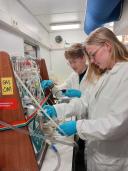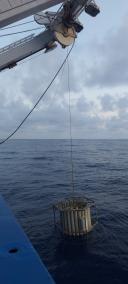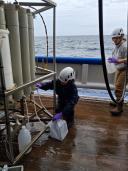The PHOSFLUX Expedition

Welcome everyone! Delighted that you take an interest in our work at sea. The PHOSFLUX expedition is an NWO-funded collaborative effort with international students and researchers from Dutch and Portuguese universities and research institutes. The expedition will take us to the deep Atlantic Oceans, to more than 5 km water depth actually! We will study the essential element phosphorus, needed by all life to grow including marine algae that take up heaps of CO2 from the atmosphere.

RV Pelagia back from NICO expedition (photo: Flying Focus)
Our primary goal is to understand how the long travel of phosphorus-containing particles through the deep, deep waters of the open Atlantic Ocean changes the properties of these particles, and by that the potential for marine algae to get access to the yummy phosphorus. An interesting angle is that as you go deeper, some phosphorus-containing minerals start to dissolve (and release phosphorus) by an effect that is similar to ocean acidification; this might help us to shed light on the behavior of phosphorus in an acidified ocean under high CO2, which no one really knows. We will throw heaps of equipment at achieving our goal: water and sediment sampling devices, NIOZ-built autonomous systems that can measure chemical processes in the seafloor at 5 km depth, long cables with systems that collect sinking material (including the associated phosphorus) at different depths, and more. Check this space for updates by the cruise participants and who knows, maybe a first glimpse of some exciting new discoveries!
24 May 2025
Written by Lucia Kranawetter - NIOZ
Despite the warm temperatures on deck of RV Pelagia we feel a bit like polar researchers in our containers where we process the sediment cores from the box corer. The sediment comes from up to 4000m depth (so far) where temperatures are much lower compared to surface waters. So, we cool down our container to about 4°C and prepare ourselves for the work on our beloved sediments.
With every new location we visit it is a journey into the unknown. To keep the sediment in its original state even more precautions must be taken in our cold container. We use a “glovebox” to avoid that deeper sediment samples get in contact with oxygen. After we carefully scoop the sediment into smaller containers inside the glovebox, we centrifuge it to separate the porewater, water that is captured in the sediment, from the particles (e.g. minerals and shells). Then again, we work inside the glovebox and fill the porewater into even smaller vials for nutrient analysis that our amazing technicians, Sharyn and Dorien, can perform onboard RV Pelagia.
We take all those precautions to preserve our sediment samples but don’t know yet at which depth oxygen is actually used up during e.g. metabolic processes by microorganisms. Thankfully we have a special oxygen sensor onboard that can measure the oxygen concentration in the sediment and we can try to find the depth at which oxygen is not present anymore. However, we could not find this point so far as it appears to be much deeper than our sensor can go. So, the search for the 0% oxygen concentration point in the sediment will be continued.

Left Figure: Abby working with sediment samples inside the glovebox. Right Figure: Oxygen sensor setup (photo: NIOZ)
23 May 2025
Written by Fleur Rothstegge - Universiteit Utrecht
The water filtration team has done its part in explaining what we might need the CTD-water for, so it’s about time you hear from the chemical analysis team! During sampling, we are the first that start filling up our bottles, as we measure alkalinity and pH which are sensitive to the atmosphere. It is therefore important that no air bubbles enter the bottles and that they are thoroughly rinsed. Once that is done, we make our way down in the ship where the CO2 Powerhouse container is located. Unlike the sediment teams and water filtration teams, we do our work at a nice and steady 25 degrees Celsius. Not because we like it that way, but as you might have guessed, our samples are also sensitive to changes in temperature!

Rinsing the bottles before sampling (photo: NIOZ)
Alkalinity describes the capability of the seawater to buffer CO2, stabilizing pH. We measure alkalinity using the Versatile INstrument for the Determination of Total Alkalinity (VINDTA) which can be seen in figure 2. The VINDTA may have a very complicated look, but it also means that we solely have to press some buttons and it works for itself!

The VINDTA used to measure Total Alkalinity (photo: NIOZ)
Easy peasy! You might think, but our VINDTA has the nickname ‘Furious George’ as measurements do not always go the way we want them to. Did the pipette fill up right? Did the acid line not have any bubbles? Are the tubes all working as planned? Much to think about indeed. But as each measurement takes about 15 minutes, we got some spare time for other things, including great music, workouts and episodes of ‘Superships’ on demand!

Measuring the temperature of the sample while already starting the next measurement! (photo: NIOZ)
22 May 2025
ALBEX: Autonomous Lander for Biological Experiments
The NIOZ ALBEX is an impressive instrument, designed to settle untethered to the ocean bottom kilometers below in order to carry out biological and chemical experiments and to collect timed samples at those extreme depths. I was eager to join the PHOSFLUX cruise to learn how to use it from Chief Scientist Peter Kraal, so that we can adapt it for experiments planned in the Amaral-Zettler group at NIOZ

A seafloor research package with buoyancy floats and sensor modules sits on the deck of a vessel, ready for deployment (photo: NIOZ)
Before launching the lander, there is a significant amount of preparation to program the instrument and associated sensors to measure temperature, oxygen, currents, and other things of interest. 30 syringes are prepared and attached to tubing to sample water at the seafloor. Despite our preparations and meticulous completion of the pre-launch checklist, I must admit to some trepidation when I saw the lifting cable released and the lander sinking slowly out of sight! The yellow “hard hats” contain glass spheres to provide floatation, and once on the seafloor, the 3 white rectangular experimental chambers are pushed by hydraulic cylinders into the sediment. Then, the top of the chamber is sealed for the duration of the experiment. The program inside the instrument instructs the various syringes to inject things into the chamber or take a sample from the chamber or surrounding seawater. In that way, we can measure the rate of biological and chemical processes on the seafloor, under natural conditions.

Left: A lot of scientific strength is necessary for manually inserting the core liners. Right: Once all cores are in, excess sediment (photo: NIOZ).
At the end of the experiment, the bottom of the chamber closes to bring up the sediment and water above it for additional sampling and measurements. Then the ship sends an acoustic signal to tell the lander to come back to the surface for recovery (first sigh of relief). At that stage, all free hands are encouraged to keep watch on deck to sight the lander and its orange flag (second even deeper sigh of relief). Once located, the ship maneuvered toward the lander for a gentle recovery. As soon as the lander is secured back on deck, the sampling of the syringes and sediment begins (biggest sigh of relief and smiling Chief Scientist)! Despite many years working at sea, it is still amazing to me to be able to send something so sophisticated down to the seafloor and recover it!

A very happy Peter Kraal aboard the ship (photo: NIOZ)
21 May 2025
Yesterday we arrived at our sixth sampling station and just like at every station, we sent the CTD down. Moving up from the bottom over 5000 meters below us, this device opens and closes its many bottles to take water samples at different depths. This water is used for a range of chemical and biological analyses, but as team water filtration we try to catch the suspended particulate matter (SPM) or the suspended organic particulate matter (SPOM) from the water.

CTD being welcomed home from its voyage into the deep (photo: NIOZ)
Our work starts when the CTD is brought in. Everybody is in a hurry to get their samples out of the sun and into their climate-controlled container-labs as fast as possible, but thanks to Ben’s great instructions we work like an oiled machine. To filter for both SPM and SPOM at eight different depths, we need 130 liters of water, which makes us the biggest consumers of CTD water on the ship.

SPOM filtration setup at work (photo: NIOZ)
Inside our container-lab, which is kept at a pleasant 5˚C, we have two filtration racks that can filter six bottles at a time each. For the shallower depths we can get enough material out of 5 liters of water, while for the deeper samples we need 10 liters. Filtering time is influenced by the concentration of particles in the water as well as the filter type and size. Altogether this means that filtering a sample can take anywhere between a half and seven hours. Thankfully we are dressed warmly and we keep our spirits high by singing along to the music!

Good times in the filtration container! (photo: NIOZ)
19 May 2025
Written by - Diana Sousa and Miguel Semedo (CIIMAR – University of Porto) Water Genomics
After one week aboard the Pelagia with the very welcoming ship’s crew and scientists from NIOZ and Dutch Universities, we are thrilled with being part of this biogeochemical and oceanographic adventure. One week ago, we were entering our Pelagia cabins for the first time, looking forward to know how our home for the next 3 weeks was going to feel like. The cabins were comfortable and the small ocean window on each cabin was a sign of what we were heading to: exploring oceanic horizons.

Cabin aboard of Pelagia (photo: NIOZ)
For us, this expedition was our first contact with this scientific team (Kraal and others), but after a week aboard it feels like we have been collaborating for months. We believe that, in general, scientists tend to collaborate. Once you share a ship/home for 24/7 with fellow colleagues it seems that there are no scientific limits for those collaborations...well, at least until our feet touch land again and all other tasks and duties arise!
Part of our work here is to study the microbial genomes present in the different depth layers of the water column at the sampled stations. By investigating the microbial genomes, we can find patterns of genetic diversity and functional potential that can contribute to explain the biogeochemical processes occurring at the different depths, from the surface to the bottom water, more than 3000m deep.

Researchers wearing gloves and safety gear draw water from a CTD rosette sampler on a ship, with the ocean visible in the background (photo: NIOZ)
To study these microbial genomes, we are filtering liters of seawater collected by the CTD-Rosette system of Pelagia to concentrate the 105-106 microbial cells per mL of seawater and extract their DNA once we’re back at CIIMAR. During the past week, we have filtered 30 samples of 5L seawater, which roughly means we concentrated more than 1010 (10 thousand million) microbial cells to investigate their genomes once we’re back in the lab. Besides the work with the seawater microbes, we’re also working with sedimentary microbial communities from the seafloor! Stay tuned for the next posts about it!

A clean laboratory setup features dual peristaltic pumps drawing liquid from multiple plastic jugs through clear tubing for filtration (photo: NIOZ)
18 May 2025
Upon deployment of any marine research device, sample retrieval is not guaranteed. Aboard the Pelagia, scientists and deck crew must work together to optimize collection of their precious deep-sea cargo. For PhosFlux sediment work this involves the inspection of bathymetric maps for undisturbed deposits or specific seafloor features such as a seamount (sea mountain). The multi-core is the “weapon of choice,” allowing for a full suite of analysis due to its high sampling capacity and accessible design allowing for efficient processing of 12 [54 cm] cores. Despite its good looks on paper, the multi-core is not built to withstand a significantly stiff, densely packed seafloor. After the aforementioned dismal display of Station 1’s multi-corer merry-go-round extravaganza the fiercely driven Chief Scientist, Dr. Peter Kraal, devised a new plan—box corer backup.
Although, known for its robust capability in taking a short, wide core with one soup-pot sized steel cauldron box-cores are not a first choice for sediment retrieval. This is because processing requires the manual insertion of core liners into the sediment block through brute strength and scientific ingenuity, or a wooden block and some serious core strength. Only then can the box core produce four multi-core sized pistons. And they lived happily ever after…because the box core allows for less surface disturbance, therefore maximizing potential measurements for porosity, pore water, and micro-profiling experiments. Alls well that ends well, as the Pelagia sails on.

Left: A lot of scientific strength is necessary for manually inserting the core liners. Right: Once all cores are in, excess sediment (photo: NIOZ)
15 May 2025
Written by Abby Matthias - Universiteit Utrecht
The North Atlantic treated us to a halo of tropical rain encircling the PhosFlux crew’s first station location. The warm, wet conditions set the tone for the very first CTD deployment. Water samples were taken for every form of analysis imaginable, pH, total alkalinity, nutrients, and filtration for suspended matter and genomics. In four separate containers, the water team worked diligently from the 8 a.m. CTD drop to the nutrient result processing after the sun’s last rays departed.

Miguel and Diana taking 5-L samples from the CTD for water filtration (photo: NIOZ)
The H2O theme persisted throughout multi-core deployment, as almost no sediments were recovered from station 1. As in the common trials and tribulations of oceanic research, we tried not once, not twice, but three times and yet the cores came back almost empty—save for a few specks of oozy tan clay. Upon further inspection (i.e. licking), the sediment’s gritty taste revealed not the remnants of chunky peanut butter, but tiny micro-organisms known as foraminifera. Despite not having a foraminifera expert aboard, with the help of a high-resolution imaging microscope we were able to take a closer look. Please say hello to our little friends!

Rinsed foraminifera from the second multicore deployment from station 1 (photo: NIOZ)
13 May 2025
Aaaaaaaaaaand, we’re off!
After flying to Ponta Delgada (Azores) with a large part of the PHOSFLUX science team, the next day we get to board Pelagia in the harbor. For some a happy reunion with crew members they have sailed with many times, for others a first encounter with the vessel and its crew. We are joined by our Portuguese colleagues, Diana and Miguel, from the University of Porto.
Now, the preparations start. Heaps of boxes with equipment await us on board, containing all the materials we need to convert shipping containers into labs for the different experiments we will conduct during the cruise. We will show you around these mini-laboratories in coming blogs.
Tomorrow, it will start for real: we will leave the harbor of Ponta Delgada and head for the open ocean. Eager to unlock the secrets about phosphorus fluxes from surface waters into the deep ocean.
But first, we need to get ready for all the work we have planned. Keep checking this space!

Miguel and Diana, our Portuguese scientific guests, proudly posing with RV Pelagia (photo: NIOZ)

A last look at Sao Miguel as we leave for the open Atlantic Ocean (photo: NIOZ)